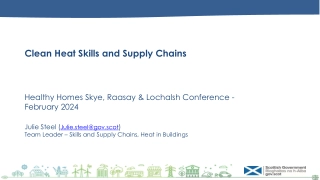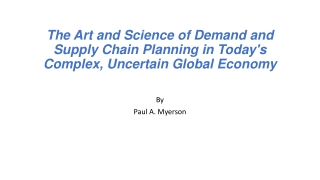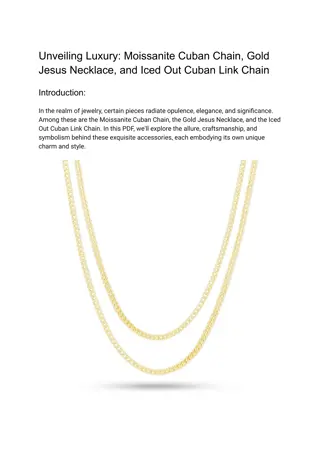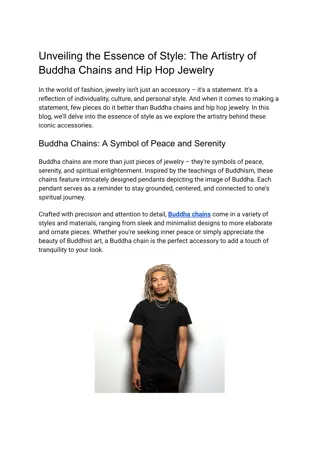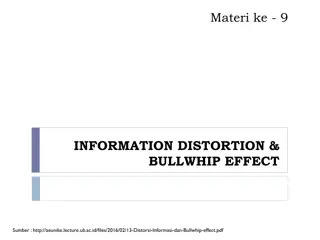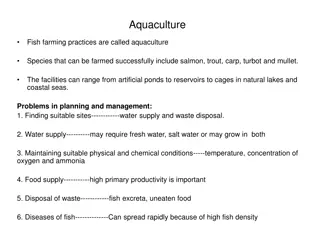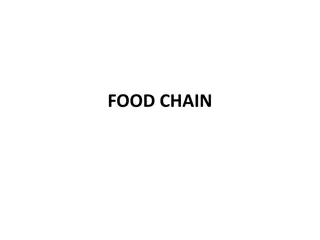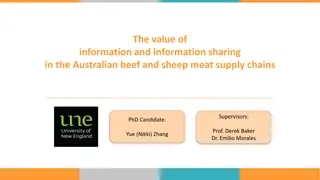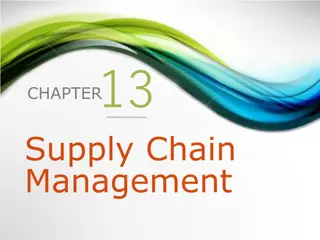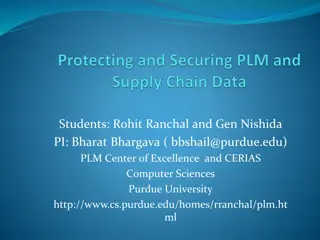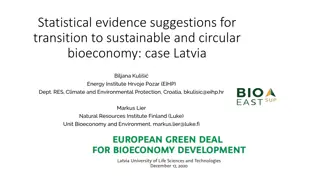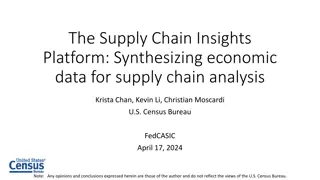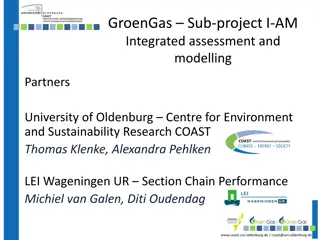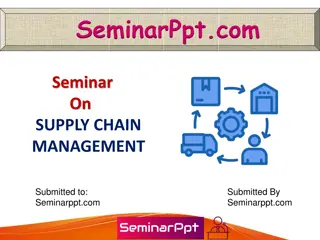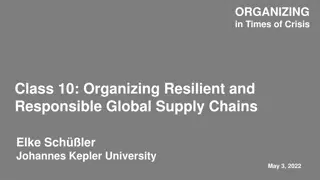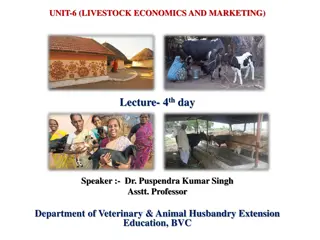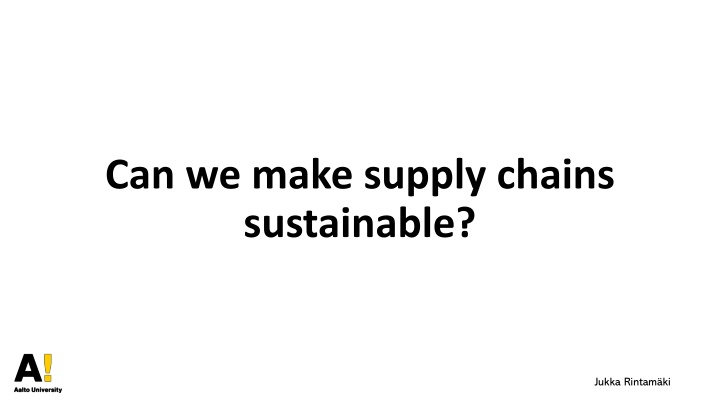
Approaching Sustainable Supply Chains
Re-connecting to strategy from a systems perspective, this discussion delves into sustainability issues within supply chains and how companies address them. Evaluating causes and consequences, the focus shifts to the grand challenge of sustainability crisis and solutions. Delving into integrated corporate sustainability and innovative approaches, the narrative explores ways to reduce unsustainability and foster individual firm sustainability towards sustainable economies and shared-benefit outcomes. Exploring robust actions and strategies, including the creation of participatory architectures and distributed experimentation, the discourse aims to tackle the challenge of making supply chains sustainable.
Download Presentation

Please find below an Image/Link to download the presentation.
The content on the website is provided AS IS for your information and personal use only. It may not be sold, licensed, or shared on other websites without obtaining consent from the author. If you encounter any issues during the download, it is possible that the publisher has removed the file from their server.
You are allowed to download the files provided on this website for personal or commercial use, subject to the condition that they are used lawfully. All files are the property of their respective owners.
The content on the website is provided AS IS for your information and personal use only. It may not be sold, licensed, or shared on other websites without obtaining consent from the author.
E N D
Presentation Transcript
Can we make supply chains sustainable? Jukka Rintam ki
Agenda Re-connect to strategy but taking a systems perspective Some basics of sustainability issues in supply chains How companies tend to try to fix issues in supply chains A critical evaluation of causes and consequences of issues in supply chains
The sustainability crisis as a grand challenge and how to approach solving it
Integrated corporate sustainability Innovative corporate sustainability Organizing sustainability Reducing unsustainability Individual firm sustainability? Sustainable economies? Broad Business-case motivation Shared-benefit aims sustainability outcomes
What are grand challenges? Complex Multiple domains Multiple locations Multiple timeframes Uncertain Future states are unknown Impossible to assign probabilities Facts alone cannot determine courses of action Evaluative Open to multiple interpretations Disciplinary boundaries difficult to draw The whole is typically not immediately visible Dynamic, non-linear Lots of interlinkages
Action that accomplishes short-term objectives while preserving long-term flexibility. Because future problems and opportunities are always uncertain, present actions should not constrict a manager s ability to adapt to new situations as they evolve Eccles & Nohria, 1992 Robust action
Robust action strategies for climate change Creation of participatory architectures Multivocal inscription Distributed experimentation with different types of approaches Source: Ferraro et al., 2015
Making supply chains sustainable
Supply chains in a nutshell Supply chain management is the coordination of production, inventory, location, coordination of production, inventory, location, and transportation and transportation among the participants in a supply chain to achieve the best mix of responsiveness and efficiency for the market being served (Hugos, 2013) Production Inventory Location Transportation Information
Why do we have supply chains? To move stuff around Contemporary form: because of Nikefication Nikefication: Technology and financialization enabled only retaining the most value-adding part of the value chain Labor is distributed along the supply chain A network of independent specialist operators However, problems ensued -> Enter Nike in 1990s
Reflect What are some of the key sustainability in issues in supply chains or their management? Social Environmental Otherwise Spend 5min discussing with your classmates
Supply chains seen as important corporate sustainability targets Source: https://www.mckinsey.com/capabil ities/operations/our- insights/future-proofing-the- supply-chain
Key problems in supply chains sustainability Sup plier Sup plier Sup plier Sup plier MNC Supply chains are very long The longer the supply chain, the lower the transparency in it Out of 1,179 companies working with rare metals, 78% where their raw materials came from 1% 1% could state with certainty their products don t The more complex the supply chain, the less likely the company knew about their conflict mineral involvement long 78% were unable to determine don t contain conflict minerals Low-tier suppliers often don t comply with sustainability requirements Environmentally harmful Violate human and labor rights Sources: Kim & Davis, 2016; Villena & Gioia, 2020
Some recent developments Source: https://www.mckinsey.com/capabil ities/operations/our- insights/future-proofing-the- supply-chain
Some recent developments Source: https://www.mckinsey.com/capabil ities/operations/our- insights/future-proofing-the- supply-chain
Recommendations for corporate approaches to tackle problems Direct: Direct: Supplier evaluation with KPIs for lower tiers, supplier surveys, working with first-tier suppliers to map the supply chain Indirect: Indirect: Provide training among first-tier suppliers to help them improve procurement from lower-tier suppliers, selecting high performing suppliers to pilot new initiatives, rewarding suppliers for cascading sustainability requirements to lower tiers Source: Villena & Gioia, 2020
Recommendations for corporate approaches to tackle problems Collective: Collective: Commit to developing industry-wide sustainability standards, share resources with competitors and major suppliers via industry associations, encourage suppliers to take part in training programs by industry associations Global: Global: Work with relevant NGOs and international institutions, use their tools and data for dealing with suppliers, recognize suppliers that attend programs by NGOs and international institutions Source: Villena & Gioia, 2020
Critical evaluation of managing sustainability in supply chains
Labor standards: How sustainability is managed in supply chains Professor Richard Locke, Brown University How to improve labor standards in global supply chains? Case: Nike Labor standards have been considered relatively effective so far Based on compliance Effectively a policing mechanism: Regular checks on suppliers on whether they comply with standards If not, they get a warning and are expected to correct their course Further warnings will get their contracts terminated Rates of standards have increased, improved results in worker surveys, improved results in the eyes of external observers Sources: Locke & Romis, 2006; Locke et al., 2007
The complexity issue A single factory can have e.g. 15 different customers with different expectations and standards The evaluation scales for each customer different Huge differences between different auditors auditing the same factory Also in between different audits by the same auditor! Problems with sustainability standards
Problems with sustainability standards New data is now emerging on what is going on with sustainability standards, and it does not paint a pretty picture Professor Sarosh Kuruvilla, Cornell University
40,000 audits across a broad range of firms and auditors About 50% of audits either could not be verified to be reliable, or were considered unreliable Audits classified as unreliable are also much more favorable (at the top end of the scores) Unreliable audits concentrate on specific auditors They have advanced software for quickly generating falsified records for their clients What the new data shows Important: Not just one retailer over a long period of time, but several different retailers, representing an across-the-board picture Source: Kuruvilla, 2021
Emergence of auditing cheating consultants Promise a pass All-inclusive service: before, during, and after audits: DPPP DPPP Generate the necessary D Documents prior to the audit Set up the factory (P Place) Provide P People to deal with the auditors Take care of the P PR What the new data shows Source: Kuruvilla, 2021
All major retailers measure their sustainability progress on supply-chain related issues through standard-based ratings, which are ultimately determined by these audit processes The norm currently in place This measure is completely unreliable, based on this newly emerged data 50% of audits unreliable! Why is this important? In short: private regulation data is not In short: private regulation data is not correlated with actual social (labor correlated with actual social (labor- -related) outcomes outcomes related) Source: Kuruvilla, 2021
Expanding this logic: How to deal with institutional parasites Source Source: Rintam ki et al., 2024
Potential solutions? Simplify the process: Have fewer standards (one per field/issue) Overlap and multiplicity create incentives for hastening the process One auditing process? Across different phases of the supply chain Increased transparency? Open databases on who have conducted which audits, publish specific results... Empower the factory workers This is what, in fact, some global brands are trying to do Sources Sources: Reinecke & Donaghey, 2021; Kuruvilla, 2021
Tightening supply chain governance: CSDDD
Summary Supply chain problems 1. Supply chains are long and complex 2. Suppliers faced with multiple conflicting pressures Low-cost requirements High, complex sustainability compliance expectations Have to absorb the costs of sustainability Supply chain solutions Simplify and regionalize supply chains Ease the pressures Organization of labor (unions) Hard regulation or a single standard to replace multiple standards Shift auditing cost to global brands
References Hugos, M. 2013. Essentials of Supply Chain Management, Essentials of Supply Chain Management, Third Edition. Wiley. Kim, Y. H., & Davis, G. F. 2016. Challenges for global supply chain sustainability: Evidence from conflict minerals reports. Academy of Management Journal Academy of Management Journal, 59(6): 1896 1916. Kuruvilla, S. 2021. Private Regulation of Labor in Global Supply Chains. Problems, Progress and Prospects Private Regulation of Labor in Global Supply Chains. Problems, Progress and Prospects. Ithaca, NY: Cornell University Press. Locke, R., Qin, F., & Brause, A. 2007. Does monitoring improve labor standards? Lessons from Nike. Industrial and Labor Relations Review Industrial and Labor Relations Review, 61(1): 3 31. Locke, R., & Romis, M. 2006. Beyond Corporate Codes of Conduct: Work Organization and Labor Standards in Two Mexican Garment Factories. SSRN SSRN, 146(1). https://doi.org/10.2139/ssrn.925273 Reinecke, J., & Donaghey, J. 2021. Political CSR at the Coalface The Roles and Contradictions of Multinational Corporations in Developing Workplace Dialogue. Journal of Management Studies 486. Rintam ki, J., Parker, S. & Spicer, A. 2024. Institutional parasites. Academy of Management Review, Villena, V. H., & Gioia, D. A. 2020. A More Sustainable Global Supply Chain. Harvard Business Review (March-April): 84 93. Journal of Management Studies, 58(2): 457 Academy of Management Review, in print. Harvard Business Review,

